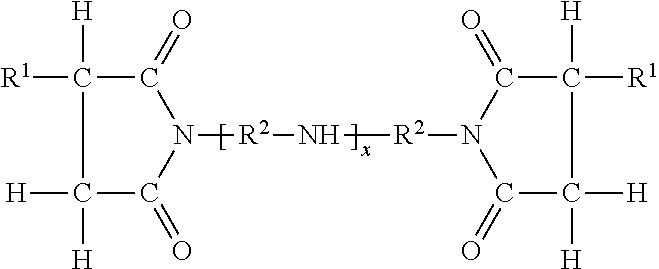Lubricating oil compositions
a technology of lubricating oil and composition, applied in the field of lubricating oil composition, can solve problems such as engine corrosion harm
- Summary
- Abstract
- Description
- Claims
- Application Information
AI Technical Summary
Benefits of technology
Problems solved by technology
Method used
Image
Examples
example 1
Step 1: Sulfurization of Tetrapropenylphenol
[0121]Into a 4 liter round flask was charged 1620 g of tetrapropenylphenol (available from Chevron Oronite Company LLC) at room temperature. The tetrapropenylphenol was heated to 110° C. in 30 minutes. At 60° C., 14 g of a 50 wt. % potassium hydroxide aqueous solution was added under agitation. Next, 192 g of sulphur flakes was added at 110° C. and the pressure was reduced to 680 mmHg. The reaction temperature was then increased to 180° C. in 30 minutes and the pressure was slowly decreased to 260 mmHg to facilitate the H2S release. H2S gas formed was trapped in concentrated potassium hydroxide solution located before the vacuum pump. The reaction conditions were held for 2 hours and 45 minutes. The pressure was the further reduced to 50 mmHg in for 15 minutes and held under those conditions for another 3 hours. The sulfurized alkylphenol reaction product was allowed to cool down. The obtained sulfurized alkylphenol had the following analy...
example 2
Neutralization and Overbasing with 2-Ethylhexanol and Ethylene Glycol
[0131]Into a 4 liter flask was charged 713.4 grams of the sulfurized alkylphenol obtained from step 2 of Example 1 with 550 grams of 130N oil, 500 g of 2 ethylhexanol, 35.2 grams of an alkylaryl sulfonic acid, and 0.2 grams of foam inhibitor SI 200 available from Dow Corning at ambient temperature. The mixture was warmed up from room temperature to 140° C. in 50 minutes. At, 60° C., 304 grams of hydrated lime was added. Next, 31 g of a 50 / 50 by weight mixture of formic and acetic acid was added dropwise in 5 minutes. At 140° C., the pressure was reduced to 680 mm Hg, 45.6 grams of ethylene glycol was added over 30 minutes while heating to 150° C. The pressure was increased back to 760 mm Hg before introducing CO2 0.6 g / min for 25 minutes at 150° C. Then the CO2 flow rate was increased to 0.8 g / min and 46.2 g of glycol was added during 45 minutes. CO2 addition was stopped when a total charge of 102.3 g was reached.
[...
example 3
Neutralization and Overbasing with Methanol and Xylene
[0133]Into a 5 liter double jacket glass reactor was mixed 243.2 g hydrated lime, 243.2 g of methanol, and 876 g of xylene. Next, 713.4 g of the sulfurized alkylphenol from step 2 of Example 1 was heated to roughly 80° C. and then diluted with 562 g of xylene. The mixture was added to the reactor in 30 minutes while the reaction temperature was increased from room temperature to 30° C. Then the reaction mixture was cooled down to 25° C. in 20 minutes. Into the mixture was added 29.6 g of a 90 / 10 mole mixture of acetic acid and formic acid in 2 minutes. The reaction mixture temperature increased due to the exothermic reaction from 25° C. to 34° C. Then 24.4 g of CO2 was added in 30 minutes while heating from 34° C. to 36° C. Next, 41.6 g of CO2 was introduced in 66 minutes while heating from 36 to 42° C. A slurry composed of 60.8 g of hydrated lime, 60.8 g of methanol, 334 g of xylene was added in 1 minute to the reactor. Next, 51...
PUM
| Property | Measurement | Unit |
|---|---|---|
| Fraction | aaaaa | aaaaa |
| Fraction | aaaaa | aaaaa |
| Fraction | aaaaa | aaaaa |
Abstract
Description
Claims
Application Information
 Login to View More
Login to View More - R&D
- Intellectual Property
- Life Sciences
- Materials
- Tech Scout
- Unparalleled Data Quality
- Higher Quality Content
- 60% Fewer Hallucinations
Browse by: Latest US Patents, China's latest patents, Technical Efficacy Thesaurus, Application Domain, Technology Topic, Popular Technical Reports.
© 2025 PatSnap. All rights reserved.Legal|Privacy policy|Modern Slavery Act Transparency Statement|Sitemap|About US| Contact US: help@patsnap.com

